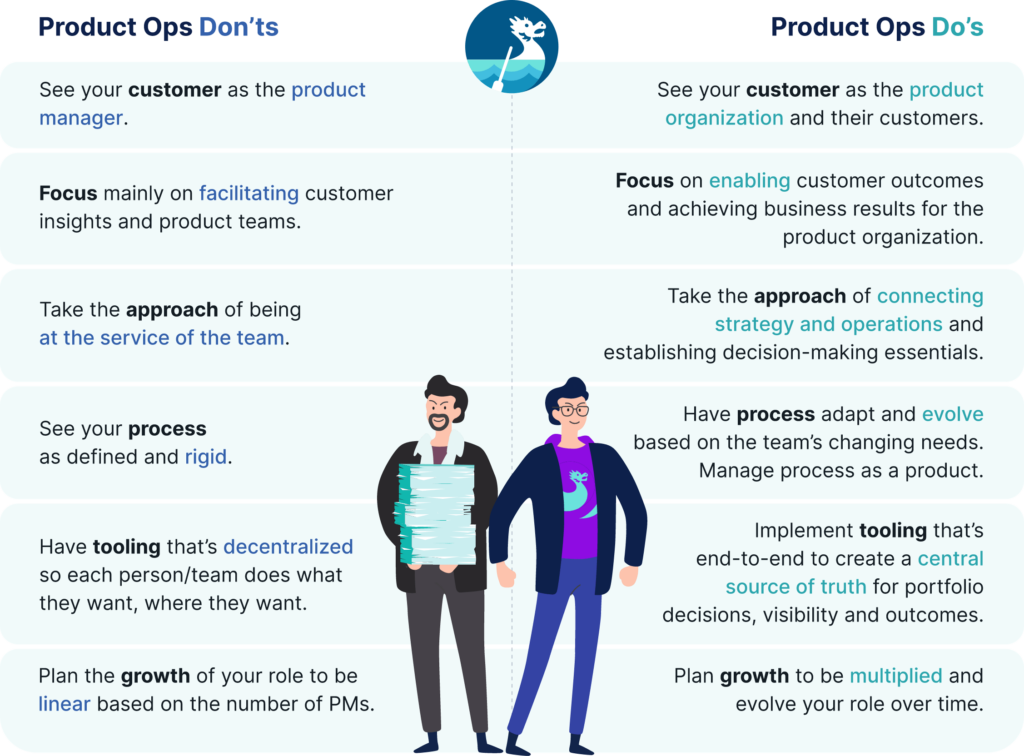Product operations (product ops) is a key function of a product organization; and a good product organization is essential to the success of any company. But the Product Ops role seems fuzzy, how do you evaluate good product ops vs bad product ops? In this post, we’ll cover the 6 key factors that differentiate good product ops from bad product ops.
- Customer – Who is the customer for product ops?
- Focus – Where should a product ops focus?
- Approach How should a product ops approach their role?
- Process – What and how processes are managed?
- Tooling – What tool stack should be adopted?
- Growth – How should a product ops team grow?
Before we start, let’s take a look at how important it is to have good product ops vs an ok product ops. For some people, Ops roles are usually considered a peripheral role. But this view is very dangerous.
Product Ops orchestrates the entire product organization connecting top, down, and across teams and functions. This makes them one of the most leveraged roles in a company.
When product ops make even a small change, it can lead to a big impact.
So, how can you be sure that what you focus on and the changes you make create the greatest impact? What should you do in order to be successful and get promoted in your role as a product ops manager? Let’s dive into these 6 key characteristics of good product ops and what you can do to accelerate your growth – both personally and professionally.
1. Good Product Ops Serve The Entire Product Organization as Customers, Bad Product Ops Serve Only Their Immediate Teams
A commonly held belief is that product ops work to serve product managers. While this is true, it’s only half the story. A great product ops manager understands that her customer is not only the company’s product managers.
“A great product ops manager will view the entire product organization and their customers (stakeholders) as the customer they are serving.”
– Becky Flint, CEO and Founder of Dragonboat
A good product ops makes the entire product organization successful. A bad product ops pleases the product managers they are grouped with.
Serving more than just one customer is an important approach for any ops role to take, not only product ops. For example, if we consider the role of sales ops, they work to serve the entire sales org, driving revenue and accelerating growth for the whole company.
2. Good Product Ops Focus On Enabling Business Outcomes, Bad Product Ops Only Facilitate Data Collection
New product ops managers often fall into the trap of focusing too much on facilitating customer insights. They may tackle this initially since it’s relatively low-risk and simple to understand and get buy-in.
However, focusing only on facilitating data collection, triaging customer feedbacks leads them to bad product ops practice, potentially missing the big picture with an overly-simplified believe what’s needed to succeed in product.
A product organization is multi-faceted and many factors drive success. The most successful product ops pros orchestrate how decisions are made, how data is gathered, and help determine how to adapt to the evolving needs of the customer, stakeholders, and the business.
This means Good product ops focus on enabling customer outcomes and achieving business results for the product organization.
Good product ops also triage the needs of the current and future market, drive near-term and long-term results, and balance these needs as the product org and company evolve as they navigate through the world they’re operating in.
3. Good Product Ops Connects Strategy and Operations, Bad Product Ops Behave like On Demand Helpers
Don’t be fooled – product operations has ops in the title, but it’s a highly strategic role. A successful product ops manager takes the opportunity to initiate critical strategic discussions and facilitate alignment between product teams and their stakeholders.
They also design and orchestrate the product and portfolio rhythm from annual/ semi-annual strategic planning, to quarterly alignment, and bi-weekly or weekly ops reviews and stakeholder engagement. Additionally, they ensure alignment on goals, access to data, prioritize holistically, and adjust all aspects of running a product organization.
“Product Operations — the art of removing obstacles from evidence-based decision making. Done right, it fuels a virtuous cycle of benefits that’ll empower everyone from the executive team all the way to each individual contributor responsible for building the products — whether Engineers, Designers or Product Managers.”
– Melissa Perri, CEO of ProduxLabs
4. Good Product Ops Manage Process as a Product, Bad Product Ops Enforce Processes No Matter What
Some call product ops the “process people,” instead of viewing them as creators. But process is not a bad thing when done right. A Process is a product that orchestrates all the moving parts related to this process to function in a cohesive way. This is why “Processor” is a core part of every computer.
Each “Process Product” is built to solve a problem and this process product needs to be managed and updated continuously along with the rest of the organization. If someone build out a large, set-in-stone, and inflexible process and they forget about the “why” behind it in the first place. What are the “jobs to be done” for that process?
To avoid this misstep, manage and iterate the “product” of process. Adapt it continuously for ever-changing needs rather than blindly following a set process. Thinking in design systems, product ops should work as an API between teams and functions, rather than being hardcoded or like a bandaid solution.
5. Good Product Ops Promote Integrated Tooling For Team and Portfolio Needs, Bad Product Ops Tolerate Siloed Tool Choices
A common challenge for product ops is to reconcile the different tools and spreadsheets used across different product teams. In response, some product ops managers will allow tooling to be decentralized so that each person/team can do what they want, where they want. This takes the form of stitching things together, creating time-intensive slide decks in PowerPoint, massive spreadsheets, and even data warehouses.
However, it is more beneficial to implement end-to-end tooling to create a central source of truth for portfolio decisions, visibility and outcomes. This is when a responsive product portfolio management tool is needed. Successful product ops find the right tool that will allow them to focus on the strategic side of the role and operating the strategy.
“We needed to have a single source of truth for idea management, a way to enable smarter outcome-based decisions, visibility for senior leadership into investments being made, and general visibility with the roadmap, because there was a lot of feeling like things would go into a “black box”, and no one would know what was coming out the other side and when.”
– Jackie Orlando, Dir of Product Ops at Tealium, on creating a single source of truth a Responsive PPM tool
Learn more about how Jackie Orlando built and scaled product operations at Tealium.
6. Good Product Ops Are Force-Multiplier, Bad Product Ops Keep Doing the Same Without Scaling
Perhaps you’ve reached the point when you’ve already figured out a strategy to make your customers successful and it’s working! So, you start wondering, where to go from here?
A common misconception about product ops is that the function grows linearly based on the number of PMs a company has. For every 10 PMs, you need 1 product ops. However, this isn’t the optimal way for product ops to grow.
As mentioned before, product ops is a highly leveraged role. A good product ops professional manages themself out of the job so they become a force multiplier. Product ops’ growth should be multiplied and evolve based on how well you serve the customer.
“I like to think of this Force Multiplier Model as having a Product Ops function at the same level as Product Management and Product Design. Product Ops is there to serve as a force multiplier to product managers, product designers and for certain activities, the product marketing managers.”
– Marty Cagan on the Force Multiplier Model of Product Ops
Become a Strategic, Outcome-Focused Product Ops Leader
Like any role, there is always a spectrum of good and bad with practices that go hand in hand with each. Contrary to the title, product ops can’t just be focused on ops. For good product ops, the goal is to think about your position as a strategic role where your mission is to lead and orchestrate the product org to achieve the best outcomes.
Here are some of the biggest do’s and don’ts that product ops managers should know:

If you’re just starting out as a product operations manager, keep in mind that your job is not just about improving efficiency, your ultimate objective is to accelerate product portfolio outcomes, just like a sales ops manager’s purpose is to ultimately accelerate revenue growth.
You can rejoice in knowing that the whole company is your customer – you can have a huge impact. As the chief enabler of your product organization, you help the company to balance the right outcomes at the right time – short vs long term customer and business needs.
So, to answer the question, “How can I get promoted as a product ops manager?” Follow these six tips and you’ll be in a much better position to be promoted, for example, to be the Director of Product Ops. Then you should be able to expand the team to increase product ops’ value exponentially!




